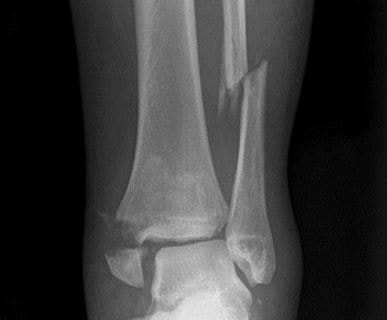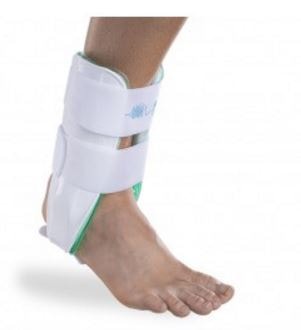Fibula Fracture
There are two bones that formed the lower leg, the fibula and the tibia. These bones are very prone to breaking of the weight that they bear. Although only around 17% of the weight is being supported by the fibula, fractures of the tibia can be associated to fibula fracture because the force is being transmitted to this bone as well [1, 2].
Fibula Fracture
The fibula is the thinner bone of the 2 lower leg bones and these are connected to each other by certain ligaments. The proximal end of the fibula does not reach the knee joint while its distal end is a component of the ankle joint and contributes to its stability. This bone serves as an anchor point for several ligaments and muscles in the leg and ankle [3].

Figure 1 shows a diagram of the fibula.
A fibular fracture pertains to a partial or complete break of the fibula. This type of fracture is uncommon and the displacement of this bone is not usually serious. Fracture may occur anywhere along the fibula and this injury usually happen with ankle sprains [4].
Types of Fibula Fracture
There are 2 major types of fibular fracture, distal and proximal fibular fracture.
Distal fibular fracture
The distal end of the fibula is called the lateral malleolus and is a part of the ankle joint. A lateral malleolus fracture occur when the outer bone of the ankle is damaged due to rolling or a direct blow to the ankle [5].
Proximal fibular fracture
Fracture of the proximal end of the fibula does not usually occur in isolation and its importance lies with injuries to the ligaments and neurovascular structures that happen along with the injury [6].
ICD10 of Fibula Fracture
The ICD-10-CM code utilized in the diagnosis of fibular fracture is S82.4 [7].
Causes of Fibula Fracture
The primary cause of the fracture is a force applied to the fibula. This may occur because of a bad landing from a jump or impact following a vehicular accident. Rotational forces applied to the fibula may cause a fracture as well [1, 8].
Signs and symptoms of Fibula Fracture
There may be moderate or severe pain that may be felt after the incident. The sharp pain may turn into an ache which may increase in the mornings and evenings. Impairment in the blood supply of the leg may cause numbness in the foot that is beyond the site of the fracture. The injured foot may not be able to bear any weight after the incident [4, 8].
Swelling and bruising may be present in the fracture site and a deformity may be visible if the fracture had caused a displacement of the fibula [4, 8].
Diagnosis of Fibula Fracture
Health history and physical examination
The cause of the injury must be known by the physician to be able to assess the injury. The lower leg will be checked for any edema, tenderness and ecchymosis. Any wounds that occur with an open fracture should be treated with antibiotics. Neurovascular assessment is essential because any deficit may require an emergent reduction of the fracture [1, 8].
Imaging Tests
If the injured leg is unable to bear any weight, a radiographic examination must be done to visualize the damage. An x-ray is the most common test that is requested because of its availability.
It will be able to show if the fibula has been broken and if there is a displacement on this bone. A Computerized Tomography (CT) scan or a Magnetic Resonance Imaging (MRI) scan may be requested to assess for the severity of the injury [1, 8].
Treatment of Fibula Fracture
The initial treatment of a fibular fracture may include application of ice on the site of the injury and elevation of the affected leg to help decrease the pain and swelling. If there is no bone displacement, the injury will in about 6 weeks with the aid of protective equipment such as a cast or walking boot. Avoiding weight bearing of the injured leg is advised to facilitate the healing [1, 4].

If the bone has been broken to several pieces, a surgical procedure that will utilize screws and metal plates to position the bone may be performed. After the procedure, strengthening the weakened leg may be done with the help of a physical therapist [1, 4].

References
- Norvell, J. (2015, September 17). Tibia and Fibula Fracture. Retrieved from eMedicine: http://emedicine.medscape.com/article/826304-overview
- Baylor, Scott & White. (2013, March 11). Fibular Fracture. Retrieved from Baylor, Scott & White: http://www.sw.org/HealthLibrary?page=Fibular%20Fracture%20with%20Rehab-SportsMed
- (2015, April 2). Fibula. Retrieved from Healthline: http://www.healthline.com/human-body-maps/fibula-bone
- UK Health Care. (April, 14 2015). Fibular Fracture. Retrieved from UK Health Care: http://ukhealthcare.uky.edu/Ortho/for-professionals/coaches-trainers/fibular/
- Crist, B. (2013, March). Ankle Fractures (Broken Ankle). Retrieved from Ortho Info: http://orthoinfo.aaos.org/topic.cfm?topic=a00391
- Melvin, J. (2008, February 10). Proximal fibular fractures. Retrieved from Orthopaedics One: http://www.orthopaedicsone.com/display/Main/Proximal+fibula+fractures
- ICD10 Data. (2015). Fracture of lower leg, including ankle. Retrieved from ICD10 Data: http://www.icd10data.com/ICD10CM/Codes/S00-T88/S80-S89/S82/S82.4-
- Physio Advisor. (2014). Lateral Malleolus Fracture. Retrieved from Physio Advisor: http://www.physioadvisor.com.au/13157250/lateral-malleolus-fracture-physioadvisor.htm
